The History Book Club discussion

This topic is about
Landslide
PRESIDENTIAL SERIES
>
PRESIDENTIAL SERIES: GLOSSARY -LANDSLIDE (SPOILER THREAD)
 George Ball:
George Ball: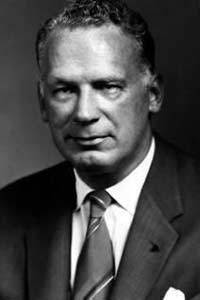
Born on December 21, 1909, in Des Moines, Iowa, George Ball studied at Northwestern University, earning a law degree in 1933. Moving to Washington, DC, he worked as a government lawyer from 1933 to 1935. In 1935, he moved to Chicago to practice tax law.
Returning to Washington in 1942, he was appointed associate general counsel for the Lend-Lease Administration. Near the end of World War II, Ball directed the US strategic Bombing Survey in London, going on to become an international lawyer representing the European Economic Community (1946-1961). In 1961, he headed the task force on trade and tariff policy for President-Elect John Kennedy. Many of his proposals became part of the Kennedy Economic Program.
On November 26, 1961, Kennedy named Ball Undersecretary of State for economic affairs. He remained at the State Department until 1966. Although he publicly opposed the Vietnam War, he was briefly appointed US Ambassador to the UN in 1968. In 1969, Ball turned to banking, working for a New York City investment banking firm until his retirement in 1982. During the Carter Administration, Ball helped draft American policy proposals in the Persian Gulf. His books include The Discipline of Power and Diplomacy for a Crowded World, as well as The Passionate Attachment, written with his son, Douglas. Ball died in New York City on May 26, 1994.
(Source: http://www.historycentral.com/Bio/peo...)
More:
http://en.wikipedia.org/wiki/George_B...
http://www.lbjlib.utexas.edu/johnson/...
 James A. Bill
James A. Bill
 John McCone:
John McCone: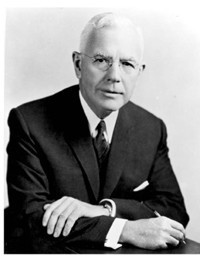
Born in San Francisco in 1902, Mr. McCone graduated from the University of California at Berkeley in 1922 with a bachelor's degree in engineering, magna cum laude.
He began his career as a riveter in a Southern California ironworks, where he later became a surveyor and, by age 26, construction manager.
After that company merged with others to form the Consolidated Steel Corp., Mr. McCone rose through positions including construction manager, vice president for sales, executive vice president and director.
In 1937, he and a partner formed their own engineering firm, the Bechtel-McCone Corp. in Los Angeles. Two years later, he helped form the Seattle-Tacoma Shipbuilding Corp., which built merchant ships.
In 1938, Mr. McCone married Rosemary Cooper of Nezperce, Idaho. She died in 1961; the couple had no children. The following year, Mr. McCone married Theiline Pigott in Seattle.
During World War II, Mr. McCone was president and general manager of the California Shipbuilding Corp., which operated the second-largest emergency shipyard in the country, building 467 ships during the war.
Through Bechtel-McCone, he also managed a plant in Alabama where B-24 and B-29 bombers were specially fitted for combat.
In 1947, Mr. McCone was appointed by President Truman to the Air Policy Commission, which recommended strengthening the nation's Air Force. He was named special deputy to the secretary of defense in 1948 and became undersecretary of the Air Force in 1950.
From 1958 to 1961, he served as chairman of the Atomic Energy Commission under President Dwight Eisenhower, a close friend and golfing partner.
Mr. McCone was out of government just a short time before being tapped by President John Kennedy to take over the CIA, which he headed during the Kennedy and Johnson administrations until 1965.
After leaving that job, he returned to his position as chairman of his steamship company, the Joshua Hendy Corp. in California.
In the years since, Mr. McCone served on many government boards and commissions, including heading a commission that looked into the causes of the 1965 riots in Los Angeles and recommended ways to improve the conditions of minorities.
He also held positions on many corporate boards, including those of International Telephone & Telegraph Co., TWA, PACCAR, Standard Oil of California and the Pacific Mutual Life Insurance Co.
(Source: http://community.seattletimes.nwsourc...)
More:
http://en.wikipedia.org/wiki/John_A._...
https://www.cia.gov/library/center-fo...
http://www.spartacus.schoolnet.co.uk/...
 JFK was noted to be patient and cautious when faced with the Cuban Missile Crisis, yet it seems as though those qualities were lacking and he might have relinquished some authority and control with regard to Vietnam.
JFK was noted to be patient and cautious when faced with the Cuban Missile Crisis, yet it seems as though those qualities were lacking and he might have relinquished some authority and control with regard to Vietnam.
 JFK installed General Max Taylor as a military adviser to act as a buffer between him and the JCS. I think this could be a problem as he was heading into the Vietnam problem.
JFK installed General Max Taylor as a military adviser to act as a buffer between him and the JCS. I think this could be a problem as he was heading into the Vietnam problem.
 I agree. It appears that Vietnam was a problem for both JFK and LBJ, who tended to be hands off rather than Commander-in-Chief.
I agree. It appears that Vietnam was a problem for both JFK and LBJ, who tended to be hands off rather than Commander-in-Chief.
 Then Taylor became JCS chief, so JFK abolished the adviser role. It does show the president pushing for his men in military spots. The DOD whiz kids also held a strong influence over the military.
Then Taylor became JCS chief, so JFK abolished the adviser role. It does show the president pushing for his men in military spots. The DOD whiz kids also held a strong influence over the military.
 Roswell Gilpatric:
Roswell Gilpatric: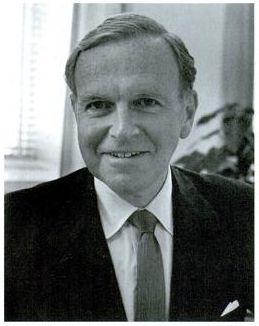
Deputy Secretary of Defense, 1961-1964; Chairman, Task Force on Nuclear Proliferation, 1964.
More:
http://en.wikipedia.org/wiki/Roswell_...
http://www.lbjlib.utexas.edu/Johnson/...
http://www.nytimes.com/1996/03/17/us/...
 Llewellyn Thompson:
Llewellyn Thompson: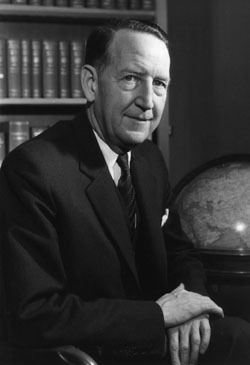
Llewellyn E. ("Tommy") Thompson Jr. served a total of seven years in Moscow in two separate tours under three Presidents; Eisenhower, Kennedy, and Johnson. The son of a Colorado rancher, he joined the Foreign Service in 1928 and served his first tour in Moscow during World War II, staying in the city while the Embassy was evacuated to Kuybyshev. Few Ambassadors to Moscow faced as many crises as Thompson - the shooting down of a U.S. U-2 reconnaissance aircraft over Sverdlovsk; a confrontation between the U.S. and Soviet Union over Berlin; the building of the Berlin Wall; difficult summits between Khruschev and Presidents Eisenhower and Kennedy; the August 1968 invasion of Czechoslovakia; and tensions over the Vietnam War. In October 1962, during the Cuban Missile Crisis, Thompson, as an Ambassador-at-Large in Washington, was a member of President John F. Kennedy's Executive Committee (ExComm), advising the President. There were also steps toward better relations, particularly during Thompson's second tour. At Thompson's suggestion, Nikita Khrushchev became the first Soviet leader to visit the U.S. in 1959. Thompson helped arrange the 1967 meeting in U.S. between President Johnson and Premier Alexei Kosygin in Glassboro, New Jersey, after the Six-Day War in the Middle East. In 1967, the Soviet Union and U.S. agreed to begin cooperation in space, with the joint Soyuz-Apollo program. The first treaty on Non-Proliferation of Nuclear Weapons was signed on July 1, 1968. Thompson's wife, Jane Monroe Goelet, an artist, originated the State Department's Art in Embassies Program at Spaso House.
(Source: http://moscow.usembassy.gov/llewellyn...)
More:
http://en.wikipedia.org/wiki/Llewelly...
http://history.state.gov/departmenthi...
 John Seigenthaler:
John Seigenthaler: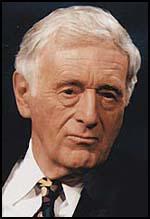
John Seigenthaler was a native of Nashville, TN who worked as a newspaper reporter at The Nashville Tennessean prior to working with Robert Kennedy on a committee investigating organized crime. In January 1961 he became a special assistant to Attorney General Robert F. Kennedy. Seigenthaler described his privileged upbringing and how it left him blind to the problems of Jim Crow.
"I grew up in the South, the child of good and decent parents..." he recalls in Freedom Riders. "I don't know where my head or heart was, or my parents' heads and hearts, or my teachers'. I never heard it once from the pulpit. We were blind to the reality of racism and afraid of change."
As special assistant to the Attorney General, Seigenthaler initially served as the intermediary between the federal government, the Freedom Riders, and white segregationist state officials. His task was to convince the Freedom Riders to cease their direct action and accept a "cooling off" period, while ensuring their physical safety from mob violence. The administration believed that as a white Southerner from Tennessee, Seigenthaler would share a common bond with Governor Patterson of Alabama and other members of the Deep South establishment.
"I'd go in, my Southern accent dripping sorghum and molasses, and warm them up," he explained.
Seigenthaler successfully arranged for the original CORE Freedom Riders to depart from Birmingham on May 15 by plane, after a lack of willing bus drivers had blocked their progress. However, he soon learned that the federal government held little sway on the issue of race relations in Alabama. He was knocked unconscious while attempting to aid two Freedom Riders during the May 20 riot at the Montgomery Greyhound Bus Station, after telling assailants to stop and respect his authority as a federal official.
Seigenthaler went on to work on Robert Kennedy's 1968 presidential campaign, before returning to journalism. He later became editor, publisher, and CEO of Nashville's The Tennessean and founding editorial director of USA Today. He founded the First Amendment Center at Vanderbilt University in 1961 with the mission of creating national discussion about First Amendment rights and values.
(Source: http://www.pbs.org/wgbh/americanexper...)
More:
http://en.wikipedia.org/wiki/John_Sei...
http://www.spartacus.schoolnet.co.uk/...
message 161:
by
Bentley, Group Founder, Leader, Chief
(last edited Oct 18, 2012 08:58PM)
(new)
-
rated it 4 stars
After reading Cheryl's post, I went hunting for LBJ ranch photos - here are a few:
http://www.kgw.com/lifestyle/entertai...
Lady Bird Johnson - Home Movie - 1965: (#30)
http://www.youtube.com/watch?v=LMuZ2d...
Lady Bird Johnson Home Movie #33: LBJ Ranch, 1965 (silent)
http://www.youtube.com/watch?v=FcKHvt...
Lady Bird Johnson Home Movie #34: Mrs. Johnson at the Virgin Islands, June 1965 (silent)
http://www.youtube.com/watch?v=CcD1qs...
http://www.kgw.com/lifestyle/entertai...
Lady Bird Johnson - Home Movie - 1965: (#30)
http://www.youtube.com/watch?v=LMuZ2d...
Lady Bird Johnson Home Movie #33: LBJ Ranch, 1965 (silent)
http://www.youtube.com/watch?v=FcKHvt...
Lady Bird Johnson Home Movie #34: Mrs. Johnson at the Virgin Islands, June 1965 (silent)
http://www.youtube.com/watch?v=CcD1qs...
 Interesting information about John Seigenthaler's role with the Freedom Riders. So far in the scheduled reading, Caro has not talked much about the Civil Rights ferment during Kennedy's presidency. It was such a significant part of the times that I'm sure it's coming.
Interesting information about John Seigenthaler's role with the Freedom Riders. So far in the scheduled reading, Caro has not talked much about the Civil Rights ferment during Kennedy's presidency. It was such a significant part of the times that I'm sure it's coming.
 Ethel Kennedy:
Ethel Kennedy:
Ethel Skakel Kennedy was born on April 11, 1928, in Chicago, Illinois to coal magnate George Skakel, a Protestant, and his devoutly Catholic wife, Ann Brannack Skakel.
Ethel’s father, George Sr., started work as an eight dollars a week railroad clerk. He, along with some co-workers, built a small coal and coke business into a diversified privately owned enterprise, the Great Lakes Coal & Coke Co., which eventually became Great Lakes Carbon Corporation. As a result, the Skakels became extremely wealthy.
In 1934, when Ethel was five years old, the family moved east, finally settling in Greenwich, Connecticut in 1936 where her father purchased a three-story, thirty-one room English country manor house on Lake Avenue where she was raised with her six siblings.
Ethel attended the all-girls Greenwich Academy in Greenwich, and Convent of the Sacred Heart in the Bronx. In September 1945, Ethel began her education at Manhattanville College of the Sacred Heart. It was here that she was introduced to Jean Kennedy with whom she became fast friends and eventually roommates.
In 1945, 17-year-old Ethel was introduced to Jean's brother, Robert F. Kennedy (Bobby) during a skiing trip to Mount Tremblant Resort in Quebec, Canada. At the time, Bobby was dating Ethel's sister, Patricia Skakel. Eventually that relationship ended and Robert and Ethel started seeing each other.
Ethel campaigned for John F. Kennedy in his 1946 campaign for U.S. Congress, and wrote her college thesis on his book Why England Slept. Bobby and Ethel became engaged in February 1950 and were married on June 17, 1950 at St. Mary’s Catholic Church in Greenwich. Their first child, Kathleen, was born on July 4, 1951.
After Robert graduated with his law degree from the University of Virginia Law School, the family settled in the Washington, D.C. area and Robert went to work for the Department of Justice.
In 1955, Ethel suffered a personal tragedy when both her parents were killed when their private airplane crashed.
In 1956, the Robert F. Kennedys purchased Hickory Hill from Robert’s brother John and his wife Jacqueline. The 13 bedroom, 13 bath home was situated on six acres in McLean, Virginia.
In 1957, Ethel's interest in politics was heightened after her husband became chief counsel to the Senate Select Committee. Two years later, she joined forces with other members of the Kennedy clan to campaign for Robert's brother, John, during his run for the U.S. presidency. In 1960, John F. Kennedy won the election, at which time he appointed Robert to the post of attorney general.
Following the 1963 assassination of John F. Kennedy, Ethel supported her husband while he campaigned for and won a seat in the U.S. Senate representing the state of New York. Like his brother, Robert also decided to enter the presidential race, but was assassinated in June 1968, immediately after he won the California Democratic primary. Six months after her husband’s death, Ethel gave birth to their 11th child, Rory.
During the late 1970s, with a renewed commitment to public service, Ethel focused much of her time and energy on various social causes, most notably the Bedford Stuyvesant Restoration Project. In 1984, she lost her son David who died from an accidental drug overdose and in 1997 her son Michael died in a skiing accident.
Ethel is the founder of the Robert F. Kennedy Memorial Centre which attempts to continue the works of Robert F. Kennedy through Human Rights Awards and Journalism Awards. She also co-chairs the Coalition of Gun Control, and is involved with other human rights organizations.
Robert and Ethel Kennedy are the parents of eleven children: Kathleen Hartington Kennedy Townsend (July 4, 1951); Joseph Patrick Kennedy II (September 24, 1952); Robert Francis Kennedy, Jr. (January 17, 1954); David Anthony Kennedy (June 15, 1955 - April 25, 1984); Courtney Kennedy Hill (September 9, 1956); Michael LeMoyne Kennedy (February 27, 1958 - December 31, 1997); Mary Kerry Kennedy (September 8, 1959); Christopher George Kennedy (July 4, 1963); Matthew Maxwell Taylor Kennedy (January 11, 1965); Douglas Harriman Kennedy (March 24, 1967); and Rory Kennedy Bailey (December 12, 1968).
(Source: http://www.jfklibrary.org/JFK/The-Ken...)
More:
http://en.wikipedia.org/wiki/Ethel_Ke...
 William O. Douglas:
William O. Douglas:
was born in Maine, Minnesota, on October 16, 1898, and raised in Yakima, Washington. He entered Whitman College in 1916, but his studies were interrupted by military service in World War I. Douglas was graduated from Whitman in 1920 and taught school for two years before attending law school at Columbia University. Upon graduation in 1925, he joined a New York law firm, but left two years later to spend one year in Yakima. He subsequently returned to teach law at Columbia University, and transferred to the faculty of Yale University in 1929. In 1936, President Franklin D. Roosevelt appointed Douglas to the Securities and Exchange Commission, and in 1937 he became Chairman. President Roosevelt nominated Douglas to the Supreme Court of the United States on April 15, 1939. The Senate confirmed the appointment on April 17, 1939. Douglas had the longest tenure of any Justice, serving on the Supreme Court for thirty-six years, spanning the careers of five Chief Justices. He retired on November 12, 1975, and died on January 19, 1980, at the age of eighty-one.
(Source: http://www.supremecourthistory.org/hi...)
More:
http://en.wikipedia.org/wiki/William_...
 Byron White:
Byron White: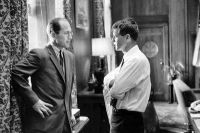
was born in Fort Collins, Colorado, on June 8, 1917, and raised in the nearby town of Wellington. He entered the University of Colorado in 1934 and was graduated in 1938. White attended Oxford University as a Rhodes Scholar for one year and then enrolled in Yale Law School. White’s education was interrupted by the United States entry into World War II. He joined the Navy, serving in the South Pacific. After the War, he completed his legal studies at Yale and was graduated in 1946. Upon graduation, White received an appointment as clerk to Chief Justice Fred M. Vinson of the United States Supreme Court for the 1946-1947 term. He then returned to Colorado and practiced with a Denver law firm for fourteen years. In 1961, White was appointed Deputy Attorney General of the United States by President John F. Kennedy. White served in that position until April 12, 1962, when President Kennedy nominated him to the Supreme Court of the United States. The Senate confirmed the appointment on April 16, 1962 and White took the oath of office that same day. Retired Justice Byron R. White died on April 15, 2002, in Colorado, at the age of eighty-four.
(Source: http://www.supremecourthistory.org/hi...)
More:
http://en.wikipedia.org/wiki/Byron_White
 Archibald Cox:
Archibald Cox:
Archibald Cox was a lawyer, professor, and public servant known for his integrity and his commitment to the greater good. He brought these traits to bear in well-reasoned legal battles for labor rights, civil rights, and government accountability.
Cox was born in 1912 in Plainfield, New Jersey, into a family of lawyers. Raised with a strong sense of public service, Cox knew early on he, too, would go into law. He was educated in private schools and graduated from Harvard College in 1932 and at the top of his class from Harvard Law School in 1937; he married Phyllis Ames that same year. After graduation, one of his professors, Felix Frankfurter, arranged for Cox to clerk for Judge (Billings) Learned Hand, who deeply impressed Cox with his sense of responsibility to the rule of law. Cox went on to work for the top Boston firm Ropes, Gray, Best, Coolidge & Rugg before entering public service during World War II.
Appointed first to the National Defense Board, Cox used his Ropes, Gray experience in labor law to help settle labor disputes that could affect defense production. Later in the war, Cox worked in the solicitor general's office under Charles Fahy, where he argued his first case in the Supreme Court, and then briefly in the State Department under Dean Acheson.
In 1946, he joined the faculty at Harvard Law School, where he would teach for the next three decades, aside from the years he was in Washington, D.C., for government appointments. Cox taught courses in labor law, constitutional law, and torts. Highly respected by students, the administration, and law enforcement officials, Cox was largely responsible for maintaining order on campus during clashes between students and police in 1969. He played a similar role at Columbia University as chair of a committee to explore political disturbances on campus in 1968.
Cox's reputation for a level head and an even hand grew from his tenure as solicitor general during the Kennedy and Johnson administrations. His first meetings with Kennedy took place in the late 1950s when he advised the then senator on labor legislation. During Kennedy's presidential campaign, Cox coordinated the involvement of academic specialists who assisted the candidate's speechwriters. From 1961 to 1965, Cox served as solicitor general, arguing the federal government's cases before the Supreme Court. Cox's successes included wins for reapportionment in the South (Baker v. Carr), safe public accommodations throughout the country for African Americans (Heart of Atlanta), and campaign-finance reform (Buckley v. Valeo). Cox contributed greatly to the success of the Civil Rights Act of 1964, and when that act was found to be lacking he was a driving force behind the writing of the Voting Rights Act of 1965. Both an idealist and a realist, he was skilled at carefully constructing a strong legal argument that was most likely to win favor with cautious judges— for instance, he argued some civil-rights cases using commerce law instead of civil-rights law. Cox's brilliant oral arguments had heart; he often incorporated stories of real people whose lives were affected by the law. Members of the court respected Cox's view that he owed a joint duty to the court and the executive branch and generally refused to advocate political positions that would conflict with legal doctrine.
In 1965, Cox returned to Harvard, only to be called back to Washington in May 1973, when he was appointed special prosecutor for Watergate. That summer, it came out that President Nixon had secret tapes of every conversation he had had in the Oval Office. Cox, along with the judge and Senate committee, pressed hard for Nixon to turn over the tapes, whole and uncensored. Fed up with Cox's insistence on unrestricted access, Nixon ordered Cox's dismissal on October 20, 1973. Attorney General Elliot Richardson and his deputy attorney general resigned rather than comply. When the Department of Justice's third man, Solicitor General Robert Bork, fired Cox, the resulting outcry from press and politicians brought not only unrestricted access to the secret tapes, but also eventually helped bring down a dishonest president.
Cox later stated that "one of the important lessons of Watergate was that unless the government trusts the people and conducts itself in an honorable fashion, then the people won't trust the government." He returned to Harvard, where he taught until 1984. From 1980 to 1992, he helmed Common Cause, a nonpartisan nonprofit citizens' lobbying group that works for an open, ethical government. He led the call for a government "effective in solving problems in ways that . . . enable each citizen to participate and to feel responsibility for the common good."
During his years at Common Cause, he wrote Freedom of Expression (1981) and The Court and the Constitution (1987); during his lifetime he authored numerous books on subjects such as labor and civil rights, as well several law textbooks. After stepping down from Common Cause, he continued to serve on boards and take an active interest in the legal world until his death in May 2004, at age 92. He was survived by his wife Phyllis, daughters Sarah and Phyllis, son Archibald Jr. and several grandchildren and great-grandchildren.
(Source: http://www.columbia.edu/cu/lweb/digit...)
More:
http://en.wikipedia.org/wiki/Archibal...
 Burke Marshall:
Burke Marshall: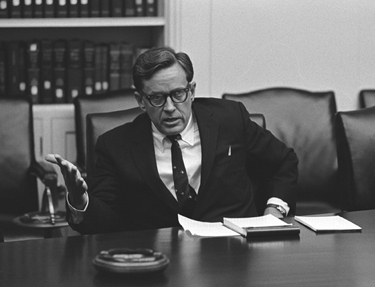
U.S. Assistant Attorney General, Civil Rights Division, Department of Justice, 1961-1965; Chairman, National Advisory Commission on Selective Service, 1966-1967.
More:
http://en.wikipedia.org/wiki/Burke_Ma...
http://www.lbjlib.utexas.edu/johnson/...
 Budd Schulberg:
Budd Schulberg: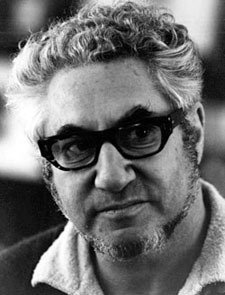
Budd Schulberg (1914-2009), screenwriter and novelist. The papers document his career as an author and screenwriter and include drafts of many of his works, such as "On the Waterfront," "What Makes Sammy Run," "The Harder They Fall," and "The Disenchanted."
More:
http://en.wikipedia.org/wiki/Budd_Sch...
http://www.nytimes.com/2009/08/06/mov...
 W. Averell Harriman:
W. Averell Harriman:
the son of the railroad magnate E.H. Harriman, W. Averell Harriman began his employment with the Union Pacific Railroad Company in 1915; he served as chairman of the board (1932–46). During the Franklin D. Roosevelt administration he was an officer of the National Recovery Administration and during 1940–41 served with the National Defense Advisory Commission and its successor agency, the Office of Production Management. In 1941 President Roosevelt sent him to Britain and the Soviet Union to expedite U.S. lend-lease aid. He then served as U.S. ambassador to the Soviet Union (1943–46), ambassador to Great Britain (April to October 1946), and secretary of commerce (1947–48).
From 1948 to 1950 he was special U.S. representative in Europe to supervise administration of the European Recovery program; in 1950 he was named special assistant to the president and in 1951 director of the Mutual Security Agency. He was twice unsuccessful in his attempt to win the Democratic nomination for the presidency (1952 and 1956). Governor of New York from 1954 to 1958, Harriman lost the position to Nelson A. Rockefeller. He served as Pres. John F. Kennedy’s assistant secretary of state for Far Eastern affairs from 1961 to 1963. During that period he advocated U.S. support of a neutral government in Laos and helped to negotiate the Nuclear Test-Ban Treaty. Under Pres. Lyndon B. Johnson Harriman served as ambassador-at-large and headed the U.S. delegation to the Paris peace talks between the United States and North Vietnam (1968–69). He retired in 1969 (though he remained active in foreign affairs in an unofficial capacity) and was replaced by Henry Cabot Lodge.
Harriman’s reflections on his relations with the Soviet Union, America and Russia in a Changing World, appeared in 1971 and his Special Envoy to Churchill and Stalin, 1941–1946 (with Elie Abel) in 1975.
(http://www.britannica.com/EBchecked/t...)
More:
http://en.wikipedia.org/wiki/W._Avere...
http://www.spartacus.schoolnet.co.uk/...
 Operation Mongoose:
Operation Mongoose:The policy assessment initiated in May 1961 led in November of that year to a decision to implement a new covert program to undermine and overthrow the Castro government in Cuba. This program was codenamed Operation Mongoose. Oversight for Operation Mongoose was provided by the 5412/Special Group expanded to include General Taylor and Attorney General Kennedy. Planning for Operation Mongoose was given additional impetus in the spring of 1962 by reports of expanded arms shipments from the Soviet Union to Cuba.
In November 1961 Kennedy approved Operation Mongoose, a secret plan aimed at stimulating a rebellion in Cuba that the United States could support. From November 1961 to October 1962 a Special Group (Augmented), whose membership was the same as the Special Group plus Attorney General Robert Kennedy and General Taylor (as Chairman), exercised responsibility for Operation Mongoose, a major covert action program aimed at overthrowing the Castro regime in Cuba. When President Kennedy authorized the program in November, he designated Brigadier General Edward G. Lansdale, Assistant for Special Operations to the Secretary of Defense, to act as chief of operations, and Lansdale coordinated the Mongoose activities among the CIA and the Departments of State and Defense. CIA units in Washington and Miami had primary responsibility for implementing Mongoose operations, which included military, sabotage, and political propaganda programs.
Bill Harvey was a legend in the Clandestine Service by this time. He had been in Berlin when the Berlin Tunnel was built to tap into Soviet communication lines in East Berlin, and he was picked to head Operation Mongoose, the attempt to undermine Fidel Castro's regime.
Throughout 1961 and 1962, US policy was to subject Cuba to economic isolation and to support stepped-up raids by anti-Castro guerrillas, many of which were planned with the assassination of Castro and other Cuban officials as a probable consequence, if not a specific objective. The Cuban Government, in turn, assumed often correctly-- that the raids were instigated and directed by the US Government. In preparation for another large-scale attack, the Castro regime sought and received increased military support from the Soviet Union.
While the Kennedy administration implemented Operation Mongoose, Soviet Premier Nikita Khrushchev secretly introduced medium-range nuclear missiles into Cuba. U.S intelligence picked up evidence of a general Soviet arms build-up during routine surveillance flights, and on September 4, 1962, Kennedy issued a public warning against the introduction of offensive weapons into Cuba. A U-2 flight on October 14 provided the first proof of Soviet medium-range ballistic missiles in Cuba. Kennedy called together 18 of his closest advisers to try to resolve the most dangerous US-Soviet confrontation of the Cold War. Some advisers argued for an air strike to take out the missiles and destroy the Cuban Air Force followed by a US invasion of Cuba; others favored warnings to Cuba and the Soviet Union. The President decided upon a middle course.
On October 22 Kennedy ordered a naval quarantine of Cuba. Kennedy responded on October 27 to the first of two letters sent by Khrushchev on October 26 and 27 proposing various settlements of the crisis. Kennedy accepted the Soviet offer to withdraw the missiles from Cuba in return for an end to the quarantine and a US pledge not to invade Cuba. The same day Attorney General Robert Kennedy told Soviet Ambassador Dobrynin that if the Soviet Union did not remove the missiles the United States would do so. Robert Kennedy also offered an assurance that Khrushchev needed: several months after the missiles were removed from Cuba, the United States would similarly remove its missiles from Turkey. On the basis of those understandings, the Soviet Union agreed on October 28 to remove its missiles from Cuba. The quarantine and the crisis lingered until the removal of the Soviet missiles was verified at sea on November 20, and the Soviet Union agreed to remove the medium-range Il-28 bombers it had also introduced into Cuba.
Following the Bay of Pigs invasion of 1961, Cuban exiles were directed and paid by CIA agents to compile secret files on and watch over other Cubans and Americans "who associated with individuals under surveillance." Anti-Castro forces in the United States were all the more embittered in the spring of 1963 when the Federal Government closed down many of their training camps and guerrilla bases. (34) In cases where government raids intercepted the illegal arms transfers, weapons were confiscated and arrests were made.
A force of Cuban exiles that had been trained and equipped by the CIA made an unsuccessful invasion of Cuba at the Bay of Pigs in mid-April 1961 in an attempt to overthrow the regime of Fidel Castro. The person responsible for overall supervision of the operation was Richard M. Bissell, Jr., the CIA's Deputy Director for Plans. Four Americans flying CIA planes, and nearly 300 Cubans died during the invasion. Over 1,200 survivors were captured by Castro's forces.
(Source: http://www.globalsecurity.org/intell/...)
More:
http://www.pbs.org/wgbh/amex/rfk/peop...
http://www.spartacus.schoolnet.co.uk/...
http://www.marxists.org/history/cuba/...
 Hickory Hill:
Hickory Hill:
An elegant 18-room white brick Georgian mansion, Hickory Hill presides over 5.6 acres dotted with massive oak and hickory trees and draped in lush rolling lawns. Visible from the road, the house has 13 bedrooms and 12 fireplaces. The property also houses a pool, children’s pool, pool house, movie theatre, paddocks and tennis court, all additions to the original property.
The first Kennedy to own the estate was the late President John F. Kennedy, with his wife, Jacqueline. The couple purchased Hickory Hill on Oct. 15, 1955 for $125,000. At the time, Kennedy was a young senator and traveled quite frequently. While living at Hickory Hill, he authored the Pulitzer-prize winning Profiles in Courage. Robert F. Kennedy and his wife, Ethel, moved into the home in 1957 after Jackie Kennedy suffered a miscarriage and the couple returned to Georgetown to live.
(Source: http://www.virginialiving.com/article...)
More:
http://en.wikipedia.org/wiki/Hickory_...
http://mclean.patch.com/articles/hick...
 Martin Luther King:
Martin Luther King:
Martin Luther King, Jr., (January 15, 1929-April 4, 1968) was born Michael Luther King, Jr., but later had his name changed to Martin. His grandfather began the family's long tenure as pastors of the Ebenezer Baptist Church in Atlanta, serving from 1914 to 1931; his father has served from then until the present, and from 1960 until his death Martin Luther acted as co-pastor. Martin Luther attended segregated public schools in Georgia, graduating from high school at the age of fifteen; he received the B. A. degree in 1948 from Morehouse College, a distinguished Negro institution of Atlanta from which both his father and grandfather had graduated. After three years of theological study at Crozer Theological Seminary in Pennsylvania where he was elected president of a predominantly white senior class, he was awarded the B.D. in 1951. With a fellowship won at Crozer, he enrolled in graduate studies at Boston University, completing his residence for the doctorate in 1953 and receiving the degree in 1955. In Boston he met and married Coretta Scott, a young woman of uncommon intellectual and artistic attainments. Two sons and two daughters were born into the family.
In 1954, Martin Luther King became pastor of the Dexter Avenue Baptist Church in Montgomery, Alabama. Always a strong worker for civil rights for members of his race, King was, by this time, a member of the executive committee of the National Association for the Advancement of Colored People, the leading organization of its kind in the nation. He was ready, then, early in December, 1955, to accept the leadership of the first great Negro nonviolent demonstration of contemporary times in the United States, the bus boycott described by Gunnar Jahn in his presentation speech in honor of the laureate. The boycott lasted 382 days. On December 21, 1956, after the Supreme Court of the United States had declared unconstitutional the laws requiring segregation on buses, Negroes and whites rode the buses as equals. During these days of boycott, King was arrested, his home was bombed, he was subjected to personal abuse, but at the same time he emerged as a Negro leader of the first rank.
In 1957 he was elected president of the Southern Christian Leadership Conference, an organization formed to provide new leadership for the now burgeoning civil rights movement. The ideals for this organization he took from Christianity; its operational techniques from Gandhi. In the eleven-year period between 1957 and 1968, King traveled over six million miles and spoke over twenty-five hundred times, appearing wherever there was injustice, protest, and action; and meanwhile he wrote five books as well as numerous articles. In these years, he led a massive protest in Birmingham, Alabama, that caught the attention of the entire world, providing what he called a coalition of conscience. and inspiring his "Letter from a Birmingham Jail", a manifesto of the Negro revolution; he planned the drives in Alabama for the registration of Negroes as voters; he directed the peaceful march on Washington, D.C., of 250,000 people to whom he delivered his address, "l Have a Dream", he conferred with President John F. Kennedy and campaigned for President Lyndon B. Johnson; he was arrested upwards of twenty times and assaulted at least four times; he was awarded five honorary degrees; was named Man of the Year by Time magazine in 1963; and became not only the symbolic leader of American blacks but also a world figure.
At the age of thirty-five, Martin Luther King, Jr., was the youngest man to have received the Nobel Peace Prize. When notified of his selection, he announced that he would turn over the prize money of $54,123 to the furtherance of the civil rights movement.
On the evening of April 4, 1968, while standing on the balcony of his motel room in Memphis, Tennessee, where he was to lead a protest march in sympathy with striking garbage workers of that city, he was assassinated.
(Source: http://www.nobelprize.org/nobel_prize...)
More:
http://en.wikipedia.org/wiki/Martin_L....
http://www.encyclopediaofalabama.org/...
http://www.thekingcenter.org/
 Birmingham Civil Rights Campaign (1963):
Birmingham Civil Rights Campaign (1963):
As 1963 began, Martin Luther King, Jr., and the SCLC were coming off a campaign in Albany, Georgia, which the New York Herald Tribune called "one of the most stunning defeats of King's career." SCLC had spent over a year in Albany attempting to integrate the city's public facilities. Although the president of the Albany Movement, Dr. William Anderson, said that the campaign was "an overwhelming success, in that there was a change in the attitude of the people involved," King felt that, "we got nothing." The schools remained segregated; the city parks were closed to avoid integration; the libraries were integrated, but only after all the chairs were removed. SCLC official Andrew Young remembered King as being "very depressed." He was looking to start another campaign, and he badly needed a victory.
Rev. Fred Shuttlesworth of Birmingham invited King and the SCLC to Birmingham, nicknamed "Bombingham" because it was the site of eighteen unsolved bombings in black neighborhoods over a six-year span and of the vicious mob attack on the Freedom Riders on Mother's Day 1961. In 1963, the city government was undergoing a major change. Voters decided to rid the city of the three-man city commission and instead elect a mayor, mostly to force Bull Connor, commissioner of public safety and the man largely responsible for the attack on the Freedom Riders, to step down. Connor ran for mayor but the voters elected the more moderate Albert Boutwell instead. The city commission, however, refused to step down, leaving Birmingham with two city governments until the courts decided which was the legitimate one.
In the midst of this change, SCLC launched "Project C" (for Confrontation). On "B Day" (for Birmingham), April 3, 1963, SCLC staged sit-ins and released a "Birmingham Manifesto," which was largely ignored, to reporters. made much of an impact.
On April 6, police arrested 45 protesters marching from Sixteenth Street Baptist Church to city hall. The next day, Palm Sunday, more people were arrested. In addition, two police dogs attacked nineteen-year-old protester Leroy Allen as a large crowd looked on. In response to the protests, Judge W.A. Jenkins, Jr., issued an order preventing 133 of the city's civil rights leaders, including King, his friend and fellow SCLC leader Ralph Abernathy, and Shuttlesworth from organizing demonstrations. But the Project C plan called for King to be arrested on Good Friday, April 12. After a few hours of debate, King told his staff, "Look, I don't know what to do. I just know that something has got to change in Birmingham. I don't know whether I can raise money to get people out of jail. I do know that I can go into jail with them." King was arrested and put in solitary confinement. There, he read an ad in the Birmingham News, taken out by local white ministers, that called him a troublemaker. He responded to the ad, writing in the margins of the newspaper and on toilet paper. His response was eventually published as his "Letter from Birmingham Jail":
While confined here in the Birmingham City Jail, I came across your recent statement calling our present activities "unwise and untimely" . . . . Frankly I have never yet engaged in a direct action movement that was "well timed," according to the timetable of those who have not suffered unduly from the disease of segregation. For years now I have heard the word "Wait!" It rings in the ear of every Negro with a piercing familiarity. This "wait" has almost always meant "never."
King was released on April 20. Meanwhile, SCLC organizers started to plan "D Day." Unlike the other demonstrations, all of the D Day demonstrators would be children. James Bevel explained why the SCLC turned to children as demonstrators:
Most adults have bills to pay -- house notes, rents, car notes, utility bills -- but the young people . . . are not hooked with all those responsibilities. A boy from high school has the same effect in terms of being in jail, in terms of putting pressure on the city, as his father, and yet there's no economic threat to the family, because the father is still on the job."
On May 2, children, ranging in age from six to eighteen, gathered in Kelly Ingram Park, across the street from Sixteenth Street Baptist Church. Around 1:00, fifty teenagers left the church and headed for downtown, singing "We Shall Overcome." They were arrested and placed in police vans. Another group left the church, and they were also put in vans. Another group left, and another. Soon the police began stuffing the protesters in school buses because there were no more vans. Three hours later, there were 959 children in jail. The jails were absolutely packed.
The next day, over a thousand more children stayed out of school and went to Kelly Ingram Park. Bull Connor was determined not to let them get downtown, but he had no space left in his jails. He brought firefighters out and ordered them to turn hoses on the children. Most ran away, but one group refused to budge. The firefighters turned even more powerful hoses on them, hoses that shot streams of water strong enough to break bones. The force of the water rolled the protesters down the street. In addition, Connor had mobilized K-9 forces, who attacked protesters trying to enter the church. Pictures of the confrontation between the children and the police shocked the nation. The entire country was watching Birmingham.
The demonstrations escalated. Because the jails were filled, the police did not know what to do. Finally, the Birmingham business community, fearing damage to downtown stores, agreed to integrate lunch counters and hire more blacks, over the objections of city officials. King had gotten his much-needed victory.
(Source: http://www.watson.org/~lisa/blackhist...)
More:
http://en.wikipedia.org/wiki/Birmingh...
http://www.detroits-great-rebellion.c...
http://en.wikipedia.org/wiki/Letter_f...
 Diane McWhorter
Diane McWhorter Frank Sikora
Frank Sikora
 Barry Goldwater:
Barry Goldwater: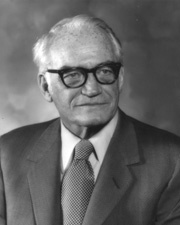
(father of Barry Morris Goldwater, Jr.), a Senator from Arizona; born in Phoenix, Maricopa County, Ariz., January 1, 1909; attended the Phoenix public schools, Staunton Military Academy, and one year at the University of Arizona at Tucson in 1928; began business career in 1929 in family mercantile business; during the Second World War entered active service in August 1941 in the United States Army Air Corps, serving in the Asiatic Theater in India, and was discharged in November 1945 as a lieutenant colonel with rating as pilot; organized the Arizona National Guard 1945-1952; brigadier general in the Air Force Reserve in 1959 and promoted to major general in 1962; retired in 1967 after thirty-seven years service; member of advisory committee, Indian Affairs, Department of the Interior 1948-1950; member of the city council of Phoenix 1949-1952; elected as a Republican to the United States Senate in 1952; reelected in 1958, and served from January 3, 1953, to January 3, 1965; did not seek reelection to the Senate in 1964; unsuccessful Republican nominee for President in 1964; elected to the United States Senate in 1968; reelected in 1974 and again in 1980, and served from January 3, 1969, to January 3, 1987; did not seek reelection in 1986; chairman, Select Committee on Intelligence (Ninety-seventh and Ninety-eighth Congresses), Committee on Armed Services (Ninety-ninth Congress); awarded the Presidential Medal of Freedom on March 12, 1986; died May 29, 1998, at Paradise Valley, Ariz.; remains were cremated.
(Source: http://bioguide.congress.gov/scripts/...)
More:
http://en.wikipedia.org/wiki/Barry_Go...
http://thecontenders.c-span.org/Conte...
http://www.washingtonpost.com/wp-srv/...
http://bioguide.congress.gov/scripts/...
http://spartacus-educational.com/USAg...
 Robert Alan Goldberg (no photo)
Robert Alan Goldberg (no photo)

 Barry Goldwater
Barry Goldwater by
by
 Rick Perlstein
Rick Perlstein
 John Tower:
John Tower: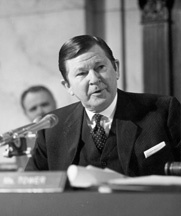
a Senator from Texas; born in Houston, Harris County, Tex., September 29, 1925; educated in the public schools of Houston and Beaumont, Tex.; enlisted in the Navy during the Second World War in 1943, saw action in the Pacific, and was discharged with the rank of seaman first class in 1946; graduated from Southwestern University, Georgetown, Tex., 1948, and with a graduate degree from Southern Methodist University, Dallas, Tex., 1953; attended London School of Economics and Political Science; member of the faculty of Midwestern University, Wichita Falls, Tex., 1951-1960; elected as a Republican to the United States Senate, May 27, 1961, to fill the vacancy caused by the resignation of Lyndon B. Johnson for the term ending January 3, 1967; reelected in 1966, 1972 and 1978 and served from June 15, 1961, to January 3, 1985; did not seek reelection; chairman, Republican Policy Committee (Ninety-third through Ninety-eighth Congresses), Committee on Armed Services (Ninety-seventh and Ninety-eighth Congresses); appointed a member of the United States arms negotiation team in Geneva, Switzerland, by President Ronald Reagan 1985; chairman, President’s Special Review Board (“Tower Commission”) 1987; appointed Secretary of Defense in 1989 by President George Bush but not confirmed; chairman, President’s Foreign Intelligence Advisory Board 1989; was a resident of Dallas, Tex., until his death in a plane crash near Brunswick, Ga., April 5, 1991; interment in Hillcrest Mausoleum, Dallas, Tex.
(Source: http://bioguide.congress.gov/scripts/...)
More:
http://www.tshaonline.org/handbook/on...
http://www.lbjlib.utexas.edu/johnson/...
http://en.wikipedia.org/wiki/John_Tower
(no image)Consequences: A Personal And Political Memoir by John G. Tower
 Ralph Yarborough:
Ralph Yarborough:
a Senator from Texas; born in Chandler, Henderson County, Tex., June 8, 1903; attended the public schools of Chandler and Tyler, Tex.; attended the United States Military Academy, West Point, N.Y., in 1919 and 1920 and the Sam Houston State Teachers College, Huntsville, Tex., in 1921; taught school for three years in Delta and Martin Springs, Henderson County, Tex.; spent one year working and studying foreign trade and international relations in Europe, mostly in Germany as assistant secretary for the American Chamber of Commerce in Berlin; served in the Thirty-sixth Division, Texas National Guard, from private to staff sergeant 1923-1926; graduated from the University of Texas Law School in 1927; admitted to the bar and commenced practice in El Paso, Tex.; assistant attorney general of Texas 1931-1934; member, board of directors of the Lower Colorado River Authority 1935; unsuccessful candidate for State attorney general in 1938; lectured on land law at University of Texas Law School in 1935; elected and served as district judge of the Fifty-third Judicial district, Austin, Tex., 1936-1941, and for three years was presiding judge for the third administrative judicial district; during the Second World War served in Army ground forces in Europe and Japan from 1943 until discharged as a lieutenant colonel in 1946; author; member of Texas Board of Law Examiners 1947-1951; unsuccessful candidate for the gubernatorial nomination in 1952, 1954, and 1956; elected as a Democrat to the United States Senate in a special election on April 2, 1957, to fill the vacancy caused by the resignation of Price Daniel for the term ending January 3, 1959; reelected in 1958 and 1964 and served from April 29, 1957, to January 3, 1971; unsuccessful candidate for renomination in 1970 and for nomination in 1972; chairman, Committee on Labor and Public Welfare (Ninety-first Congress); member, Interparliamentary Union Group 1961-1970; member, board of directors, Gallaudet College 1969-1971; member, constitutional revision commission of Texas 1973-1974; member, State library and archives commission of Texas 1983-1987; practiced law in Austin, Tex., was a resident of Austin, Tex., until his death on January 27, 1996; interment in Texas State Cemetery, Austin.
(Source: http://bioguide.congress.gov/scripts/...)
More:
http://www.tshaonline.org/handbook/on...
http://en.wikipedia.org/wiki/Ralph_Ya...
(no image)Yarborough Of Texas by William G. Phillips
 Patrick L. Cox
Patrick L. Cox
 Sarah McClendon:
Sarah McClendon: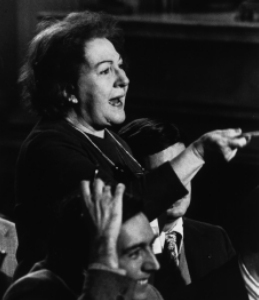
Sarah McClendon was born in Tyler, Texas on July 8, 1910. She graduated from Tyler Junior College and the University of Missouri, School of Journalism. Her first major news story was the New London, Texas school explosion in March 1937. After reporting for local newspapers in Tyler and Beaumont, she enlisted in the Women’s Army Corps where she obtained the rank of first lieutenant. In addition to a position as a Pentagon public affairs officer, she was the first WAC to serve in the Office of the Army Surgeon General. After World War II she remained in Washington and opened the McClendon News Service, a syndication service which primarily served newspapers in Texas. Her columns and newsletters were also syndicated nationally (the most prominent being “Sarah McClendon’s Washington” column and her biweekly newsletter, “Sarah McClendon’s Washington Report.”) As a Washington press correspondent, Sarah McClendon covered eleven presidential administrations, from Franklin D. Roosevelt to Bill Clinton. She also reported regularly on Congress and the Defense Department, in addition to serving as a popular radio and television analyst. Sarah McClendon was also a regular speaker at universities, think tanks, Washington, D.C. events, and programs for veterans, women, and journalists. She authored two books, My Eight Presidents (Wyden Books, 1978) and Mr. President, Mr. President (General Publishing Group, 1996). McClendon was best known for her sharp, direct questions of presidents and public officials. Her inquiries at White House press conferences frequently attracted national attention, including her questions to Kennedy about security risks in the State Department, Eisenhower about mobilizing troops in Lebanon without Congressional consent, and George H.W. Bush about his involvement in the Iran-Contra affair. Further publicity resulted from her questions to President Nixon about delayed GI Bill payments (which resulted in major restructuring at the Veterans Administration) and to President Reagan about his administration’s treatment of women. Sarah McClendon held multiple offices in national organizations, including terms as vice-president of the National Press Club (the first woman to hold the office), president of the American News Women’s Club, vice-chairman of the National Woman’s Party, and president of the Capitol Hill First Friday Club. She also held many appointed offices, including positions on the Defense Advisory Committee on Women in the Services (DACOWITS), Veterans Administration Advisory Committee on Women Veterans, the Army Advisory Task Force on Women in the Army Policy Review, and the National Council of the National Woman’s Party. Sarah McClendon received many awards and honors, including a place in the Washington D.C. Society of Professional Journalists Hall of Fame (Sigma Delta Chi); a Headliner award from Women in Communications; First Presidential Award for Covering Washington from the National Federation of Press Women; Media Award from the Veterans of Foreign Wars; the American Woman award from the Women's Research and Education Foundation; the Woman of Conscience Award from the National Council of Women; Association of Government Communicators Award; the Elizabeth Boyer Award from the Women’s Equity Action League; the University of Missouri’s Distinguished Alumnus Award; and the Golden Eagle Award presented to her in 1991 by the University of Texas at Tyler. She passed away in Washington, D.C. in January 2003.
(Source: http://archon.uttyler.edu/?p=collecti...)
More:
http://usatoday30.usatoday.com/news/w...
http://en.wikipedia.org/wiki/Sarah_Mc...
(no image)My eight presidents &
 Sarah McClendon
Sarah McClendon
 John J. Williams:
John J. Williams: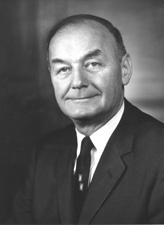
a Senator from Delaware; born on a farm near Frankford, Sussex County, Del., May 17, 1904; attended the public schools at Frankford; moved to Millsboro, Del., in 1922 and engaged in the grain business; elected as a Republican to the United States Senate in 1946; reelected in 1952, 1958 and 1964 and served from January 3, 1947, until his resignation December 31, 1970; was not a candidate for reelection in 1970; died on January 11, 1988, in Lewes, Del.; interment in Millsboro Cemetery, Millsboro, Del.
(Source: http://bioguide.congress.gov/scripts/...)
More:
http://en.wikipedia.org/wiki/John_J._...
 Benjamin Everett Jordan:
Benjamin Everett Jordan: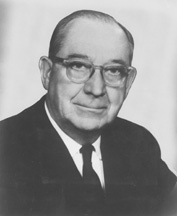
a Senator from North Carolina; born in Ramseur, Randolph County, N.C., September 8, 1896; attended the public schools, Rutherford (N.C.) College Preparatory School in 1912 and 1913, and Trinity College, now Duke University, in 1914 and 1915; during the First World War served overseas with the Tank Corps, United States Army 1918-1919; organized Sellers Manufacturing Co., a textile firm, in 1927 and served as secretary-treasurer and general manager; Democratic national committeeman 1954-1958; member, North Carolina Peace Officers Benefit and Retirement Commission 1943-1958; member, North Carolina Medical Care Commission 1945-1951; chairman, Board of Trustees, Alamance County General Hospital; appointed on April 19, 1958, as a Democrat to the United States Senate, and subsequently elected November 4, 1958, to fill the vacancy caused by the death of W. Kerr Scott in the term ending January 3, 1961; reelected in 1960, and again in 1966 for the term ending January 3, 1973; unsuccessful candidate for renomination in 1972; co-chairman, Joint Committee on Inaugural Arrangements (Eighty-eighth and Ninetieth Congresses), chairman, Joint Committee on the Library (Eighty-eighth through Ninety-second Congresses), Committee on Rules and Administration (Eighty-eighth through Ninety-second Congresses), Joint Committee on Printing (Ninety-first and Ninety-second Congresses); died in Saxapahaw, N.C., March 15, 1974; interment in Pine Hill Cemetery, Burlington, N.C.
(Source: http://bioguide.congress.gov/scripts/...)
More:
http://en.wikipedia.org/wiki/B._Evere...
 Ben F. Bulla
Ben F. Bulla
 Nancy Carole Tyler:
Nancy Carole Tyler:was personal secretary to Bobby Baker and a roommate of Mary Jo Kopechne. She was involved in a call girl procurement service in the early 1960s, which operated from a base at the Quorum Club, in Washington, D.C.. Ellen Rometsch disclosed details of this service, which provided notable Washington people, such as members of the United States Senate and the United States House of Representatives, with access to prostitutes.
Formerly secretary to George Smathers, she leaked to Baker information that President Lyndon B. Johnson was going to be dropped from the Kennedy ticket for the 1964 U.S. presidential election. Later, she refused to testify in the Senate Rules Committee investigating the allegations on Fifth Amendment grounds that it "might tend to incriminate (her)."
Tyler died in May 1965 when a small private plane in which she was a passenger was lost over the Atlantic Ocean.
(Source: http://en.wikipedia.org/wiki/Nancy_Ca...)
 Ellen Rometsch:
Ellen Rometsch: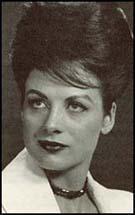
was allegedly an East German Communist spy who was assigned on diplomatic cover to the West German embassy in Washington, D.C. during the early 1960s. She is also widely thought in some Washington journalism circles to have been one of President John F. Kennedy's girlfriends during the height of the Cold War.
(Source: http://en.wikipedia.org/wiki/Ellen_Ro...)
More:
http://www.spartacus.schoolnet.co.uk/...
 Terry Sanford:
Terry Sanford:
a Senator from North Carolina; born in Laurinburg, N.C., August 20, 1917; attended Presbyterian Junior College; graduated, University of North Carolina, Chapel Hill, 1939; graduated, University of North Carolina Law School 1946; special agent, Federal Bureau of Investigation 1941-1942; parachute infantry, United States Army 1942-1945; North Carolina National Guard 1948-1960; assistant director, Institute of Government, University of North Carolina 1946-1948; lawyer in private practice 1948-1960, 1965-1969, 1985-1986; North Carolina State senator 1953-1955; Governor of North Carolina 1961-1965; president of Duke University 1969-1985; elected as a Democrat to the United States Senate on November 4, 1986, for the unexpired term of John East ending January 3, 1987, and for the six-year term ending January 3, 1993, and served from November 5, 1986, to January 3, 1993; unsuccessful candidate for reelection in 1992; chairman, Select Committee on Ethics (1992); resumed the practice of law in North Carolina and Washington, D.C.; died in Durham, N.C. on April 18, 1998; interment in Duke University Chapel.
(Source: http://bioguide.congress.gov/scripts/...)
More:
http://en.wikipedia.org/wiki/Terry_Sa...
 Howard E. Covington
Howard E. Covington
 Kennedy Assassination:
Kennedy Assassination:
On November 22, 1963, the President and the First Lady journeyed to Dallas on a campaign trip. Accompanying the Kennedys in the motorcade through the city were Governor John Connally and his wife, Nellie. As it moved through Dealey Plaza, the presidential limousine was fired upon. Governor Connally was wounded; President Kennedy who was hit twice, was killed. Kennedy was rushed to Parkland Memorial Hospital, where he died soon thereafter.
The shots had been fired from a nearby warehouse and some hours after the assassination, police arrested warehouse employee Lee Harvey Oswald.
(Source: http://millercenter.org/president/ken...)
More:
http://en.wikipedia.org/wiki/Assassin...
http://www.youtube.com/watch?v=1q91RZ...
http://www.jfklibrary.org/JFK/JFK-in-...
 William Homer Thornberry:
William Homer Thornberry: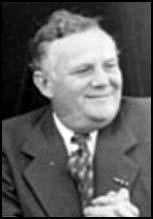
a Representative from Texas; born in Austin, Travis County, Tex., January 9, 1909; attended the public schools; B.B.A., University of Texas, 1932; LL.B., University of Texas, 1936; admitted to the bar in 1936; lawyer, private practice; member of the Texas state house of representatives, 1936-1941; district attorney of the fifty-third judicial district of Texas, 1941-1942; United States Navy, 1942-1946; member of the Austin, Tex., city council, 1946-1948, mayor pro tempore, 1947-1948; delegate at large to the Democratic National Conventions, 1956 and 1960; elected as a Democrat to the Eighty-first and to the seven succeeding Congresses, served until his resignation on December 20, 1963 (January 3, 1949-December 20, 1963); United States district judge for the western district of Texas, 1963-1965, circuit judge of the United States Court of Appeals of the Fifth Judicial Circuit, 1965-1995; nominated to the United States Supreme Court, 1968; died on December 12, 1995, in Austin, Tex.
(Source: http://bioguide.congress.gov/scripts/...)
More:
http://en.wikipedia.org/wiki/Homer_Th...
http://www.spartacus.schoolnet.co.uk/...
 Rufus Youngblood:
Rufus Youngblood:
was a United States Secret Service agent best known for using his body to shield Vice President Lyndon B. Johnson during the assassination of John F. Kennedy in Dallas, Texas on November 22, 1963.
(Source: http://en.wikipedia.org/wiki/Rufus_Yo...)
More:
http://www.nytimes.com/1996/10/04/us/...
http://www.spartacus.schoolnet.co.uk/...
http://gtalumni.org/Publications/maga...
(no image)20 Years In The Secret Service: My Life With Five Presidents by Rufus W. Youngblood
 Jack Valenti:
Jack Valenti: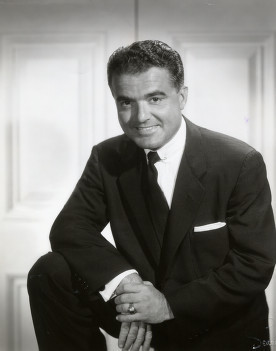
Jack Valenti was born into a second-generation Italian-American family in Houston, Texas, on September 5, 1921. All four of his grandparents had immigrated to the United States from Sicily in the 1890s. Jack grew up on an unpaved road called Alamo Street in a working-class neighborhood, and his father was a clerk in Houston's county tax office. As a young boy who tried to help his family manage in difficult economic conditions, Jack always had jobs. He helped out in his grandfather's grocery store, sold newspapers on the street corners, and showed people to their seats in a Houston movie house called the Iris Theater.
The Valentis were a large Italian-American family with lots of cousins, babies, lively conversations, and big Sunday afternoon dinners. Jack's grandfather and great uncle were respected leaders in Houston's Sicilian community; their support was looked upon as crucial by local politicians. Valenti says his grandfather's leadership was his first introduction to politics, and he proudly speaks of the fact that upon his grandfather's death the Houston Chronicle listed Captain James A. Baker, grandfather of Jim Baker, as one of the honorary pallbearers.
At Sam Houston High School Valenti was a debate champion, honor student, and the school's youngest graduate ever at the age of 15. He promptly began full-time work as an office boy at the Humble Oil and Refining Company, worked his way up to the advertising department, and began evening classes at the University of Houston.
World War II took over his life from 1942 to 1945. Valenti was a highly decorated Air Force bomber pilot. After his discharge as a first lieutenant, he finished his undergraduate degree in 1946 at the University of Houston as an A-minus business major and English minor and as president of the student body. Two years later he returned to Houston with a Master's degree from the Harvard Graduate School of Business and took over the advertising and promotion department at Humble Oil.
Valenti left the company in 1952 to start his own advertising agency with Weldon Weekley, a classmate from the University of Houston. Weekley and Valenti, Inc., quickly became representatives of the powerful in the Houston business community as well as the powerful in Texas politics. Their political accounts included work on Dwight D. Eisenhower's presidential campaign in Texas in 1952, U.S. Representative Albert Thomas' run for Congress, John Connally's campaign for governor of Texas, and Lyndon Johnson's presidential campaign during the primaries of 1960.
Valenti had been named Outstanding Young Man of Houston in 1956, and later that year at a gathering of other young businessmen in Houston he met then-Senator Lyndon Baines Johnson. Valenti left that meeting greatly impressed, thinking of Johnson as a man who possessed strength and intelligence combined with humility and earnestness.
After he handled the press in Houston for President John F. Kennedy's November 1963 visit to Texas, Valenti's performance so impressed the vice president that Johnson convinced him to fly with the Kennedy/Johnson entourage to Fort Worth and then on to Dallas and Austin, where they would talk about the future. As Jack Valenti rode in the president's motorcade toward Dealey Plaza on November 22, 1963, the excitement of being recruited as a member of the vice president's staff turned to shock and bewilderment, when President Kennedy was assassinated by Lee Harvey Oswald. That night he found himself on Air Force One headed for Washington as one of the first staff members of President Lyndon Johnson.
In addition to becoming a close personal friend of the president, Valenti was his closest adviser, consultant, and assistant. He performed tasks at the White House in the areas of congressional relations, diplomatic matters, speech editing, and foreign relations. He attended cabinet and National Security Council meetings and was trusted with many confidential assignments. The press was skeptical and sometimes critical of Valenti's role in the White House, and rumor said that he was constantly at the mercy of Johnson's cruel scoldings and tempestuous moods. Stories were circulated that Johnson often humiliated Valenti in front of others, but Valenti refuted the reports and never spoke publicly of the president without the highest praise and loyalty.
Soon after he had taken over national security duties in April 1966, which were formerly performed by McGeorge Bundy and Bill Moyers, Valenti announced that he was leaving the White House to become president of the Motion Picture Association of America (MPAA). He spoke of his love for movies, but also of his attraction to the significant salary increase he would incur.
(Source: http://www.answers.com/topic/jack-val...)
More:
http://en.wikipedia.org/wiki/Jack_Val...
 Bill Moyers:
Bill Moyers: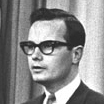
During the Kennedy Administration, Moyers was first appointed as associate director of public affairs for the newly created Peace Corps in 1961. He served as Deputy Director from 1962 to 1963. When Lyndon B. Johnson took office after the Kennedy assassination, Moyers became a special assistant to Johnson, serving from 1963 to 1967. He played a key role in organizing and supervising the 1964 Great Society legislative task forces and was a principal architect of Johnson's 1964 presidential campaign. Moyers acted as the President's informal chief of staff from October 1964 until 1966. From July 1965 to February 1967, he also served as White House press secretary.
(Source: http://en.wikipedia.org/wiki/Bill_Moyers)
More:
http://billmoyers.com/about-us/#Bill%...
 Chester Clifton, Jr:
Chester Clifton, Jr:
was a Major General in the United States Army and an aide to Presidents John F. Kennedy and Lyndon B. Johnson.
More:
http://en.wikipedia.org/wiki/Chester_....
http://www.arlingtoncemetery.net/cvcl...
 Rose Kennedy:
Rose Kennedy:
Born on July 22, 1890, in Boston, Rose Kennedy was the grande dame of contemporary American politics, seeing three of her children find great success. Success came with even more tragedy for Kennedy, as she lost two children in the 1940s and sons John and Bobby were assassinated in the 1960s. She died at age 104 and is survived by five of her children, 28 grandchildren, and 41 great-grandchildren.
(Source: http://www.biography.com/people/rose-...)
More:
http://en.wikipedia.org/wiki/Rose_Ken...
http://www.jfklibrary.org/JFK/The-Ken...
(no image)Rose Kennedy: The Life and Times of a Political Matriarch by Barbara A. Perry
 Rose Fitzgerald Kennedy
Rose Fitzgerald Kennedy
 Lee Harvey Oswald:
Lee Harvey Oswald:
Accused Assassin of 35th US President John F. Kennedy. Born in New Orleans, Louisiana, the son of Robert Edward Lee Oswald and Marguerite Claverie. His father died of a sudden heart attack, and Lee was raised by a succession of step-fathers. Growing up, he was considered a loner, not very good academically, and dropped out of high school when he was 15. When he was 16, he took an interest in Communism, and applied to join the Socialist Party of America, but nothing came of the application. In 1956, he joined the United States Marine Corps, and was trained as an Aircraft Maintenance Repairman (despite stories to the contrary, he never learned to fire his rifle as an "expert" and was never trained as a sniper). He was stationed in El Toro MCAS, California, and Atsugi MCAS, Japan (near Tokyo). He was court-martialed twice, once for keeping a private weapon (pistol) in his locker without permission, and once for assaulting an NCO. During this period, he remained a loner, and upon receiving his discharge in 1959, he used his savings to travel to Russia. The Russians assigned him to a radio and television factory in Minsk, and treated him well, giving him the pay and an apartment equivalent to a plant manager, as they did with all western defectors. Despite this, he became disenchanted with the USSR, and in 1961, he decided to return to the United States. In March 1961, while waiting for permission to return to the US, he met Marina Prusakova at a dance, and they were married on April 30, 1961. In June 1962, he, his wife, and their daughter were allowed to leave Russia, and they returned to Fort Worth, Texas. Although disillusioned with the Soviet Union, Lee Harvey Oswald remained "Marxist," even though his understanding of the communist system was limited. After the assassination of President Kennedy on November 22, 1963, he shot Dallas Police Officer J.D. Tippit, killing him. Arrested for the death of Officer Tippit, and later charged with the death of President Kennedy, he was shot and killed by Jack Ruby in the Dallas Police Station on live television, an act that shocked the already stunned nation. Despite the fact that the later Warren Commission declared that Lee Harvey Oswald was the assassin of President Kennedy, and he acted alone, many conspiracies about the assassination abound to the present day.
(Source: http://www.findagrave.com/cgi-bin/fg....)
More:
http://en.wikipedia.org/wiki/Lee_Harv...
http://www.pbs.org/wgbh/pages/frontli...
http://www.spartacus.schoolnet.co.uk/...
http://www.youtube.com/watch?v=0xU7Lh...
http://www.archives.gov/research/jfk/...
 R. Sargent Shriver:
R. Sargent Shriver:
Robert Sargent Shriver was born on November 9, 1915 in Westminster, Maryland to Robert and Hilda Shriver. After graduating from the Canterbury School in New Milford, Connecticut, which he attended on a full scholarship, Shriver spent the summer in Germany as part of the Experiment in International Living, returning in the fall of 1934 to begin college at Yale University. By his sophomore year, despite financial difficulties, Shriver became the senior editor for the Yale Daily News. The following summer, Shriver was once again invited to participate in the Experiment for International Living, but this time as a leader of a small group of students. Shriver graduated from Yale in 1938 and, with the help of scholarships, family, and friends, enrolled in Yale Law School.
Shriver maintained a link to the Experiment for International Living while in law school, and he led a third group of students to France in the summer of 1939, when World War II was just beginning. Back at Yale, he enlisted in a summer program in the Navy and, at the same time, protested actively against America’s involvement in the war. After he graduated law school in 1941, he reported to duty in the Navy and was assigned to a new battleship, the South Dakota. Shriver served as a gunner in two large battles during 1942: the Battle of Santa Cruz and the Battle of Guadalcanal. Shriver next trained as a submariner, and on March 13, 1945 he was given the assignment of gunnery and torpedo officer on the USS Sandlance.
After the war, Shriver returned to New York City, working briefly at the law firm of Winthrop, Stimson before becoming an assistant editor at Newsweek. It was during this time that Shriver first met Eunice Kennedy and began working for Joseph P. Kennedy at JPK Enterprises in Manhattan. Soon afterward, Shriver moved to Chicago to become the assistant general manager of the Merchandise Mart for Joseph Kennedy. In 1947 he moved to Washington, D.C. to help Eunice Kennedy on the National Conference on Prevention and Control of Juvenile Delinquency. A little less than a year passed before Shriver returned to Chicago to resume work at the Merchandise Mart.
Shriver married Eunice Kennedy on May 23, 1953. The wedding took place at St. Patrick’s Cathedral in New York City, with Cardinal Spellman, a Kennedy family friend, officiating. The Shrivers would have five children: Robert III, Maria, Timothy, Mark, and Anthony.
Shortly after the wedding, the couple settled in Chicago. In 1955, Shriver began directing both the Catholic Interracial Council, an organization established for the desegregation of schools, and the Chicago Board of Education. In 1960, Shriver coordinated the Wisconsin and West Virginia primaries for John F. Kennedy’s presidential campaign. When Kennedy was elected, Shriver was asked to direct the Talent Hunt committee to research and find appropriate candidates for top administrative and ambassadorial positions.
John F. Kennedy’s election led to what would become one of Shriver’s most important and long-lasting accomplishments, the creation of the Peace Corps. The idea for the Peace Corps originated with two speeches that John F. Kennedy gave on the campaign trail. At the University of Michigan, Kennedy introduced the idea of a youth service corps for college students. Months later, Kennedy solidified his ideas about the service corps and made it a major campaign pledge. Shriver was asked to work on a report about the feasibility of a volunteer corps that would work on projects in other countries. Shortly after receiving the report, Kennedy signed the executive order establishing the Peace Corps (Executive Order 10924). Shriver served as the Director of the Peace Corps from 1961 to 1966. During his tenure as director, Shriver traveled around the United States giving speeches about the Peace Corps in many different contexts: graduation ceremonies, honorary doctoral ceremonies, political meetings, and economic councils. Shriver also made oversea trips to Latin America, Africa, the Middle East, and Germany to review Peace Corps work being done in those countries and to make new connections for future programs.
After President Kennedy’s death on November 22, 1963, Shriver continued directing the Peace Corps while also helping to launch President Johnson’s new War on Poverty. Though there was talk that this work would result in a vice-presidential bid for Shriver in the 1964 presidential election, President Johnson chose Minnesota Senator Hubert Humphrey as his running mate instead. On 20 August 1964, Johnson signed the Office of Economic Opportunity (OEO) Act which would eventually provide job training, work study programs, loans and grants to poor farmers, and a domestic volunteer service that cooperated with local governments and communities. After having spent months laying the groundwork for the OEO, Shriver became the agency’s first director. The OEO was quickly dubbed the domestic Peace Corps, and branched into many different programs including Volunteers in Service to America (VISTA), Community Action Program (CAP), Job Corps, Head Start, and the Neighborhood Youth corps. Shriver traveled extensively throughout the country giving speeches, visiting various communities where poverty programs were in place, and encouraging others to join the War on Poverty. He resigned as Director of the OEO on April 12, 1968.
On May 7, 1968, Shriver was sworn in as the U.S. ambassador to France. His job in Paris was not expected to be an easy one, as American relations with France, and specifically with French President Charles de Gaulle, had grown increasingly strained throughout the decade. President de Gaulle had established diplomatic relations with communist China in 1964, withdrawn from the North Atlantic Treaty Organization’s (NATO) integrated military organization in 1966, publicly denounced the American war in Vietnam in 1967, and encouraged French-Canadian separatists in 1968. The United States, for their part, had consistently refused to aid France in its pursuit to become a nuclear power. The domestic situation in France proved to be difficult as well; upon his arrival in Paris Shriver encountered a severe domestic crisis involving nationwide strikes and student unrest. Despite these obstacles, Shriver and de Gaulle established a working friendship, and the Shriver family became popular and often-publicized members of Paris society. Franco-American relations began to thaw as a result of this friendship, and were furthered when de Gaulle was succeeded by his former Prime Minister Georges Pompidou in 1969. As Ambassador, Shriver was peripherally involved in the Paris Peace Talks which began in 1968 between the United States and Vietnamese officials. He also oversaw President Richard Nixon’s visit to Paris in 1969, which marked the first American state visit to France since 1961, as well as President Pompidou’s state visit to Washington, D.C. in March 1970. Despite his success as Ambassador and his family’s apparent contentment with life in Paris, Sargent Shriver’s thoughts and ambitions were never far from the political scene back in the United States. His correspondence with friends and colleagues touched on various political possibilities, including the 1968 Democratic vice presidential nomination, a nomination for Ambassador to the United Nations, a run for the governorship of Maryland, and Shriver’s consistently strong political potential in Illinois. This period was also marked by Eunice Kennedy Shriver’s organization of the First International Special Olympic Games, held in July 1968 in Chicago, and the assassination of Shriver’s brother-in-law, Robert F. Kennedy, less than a month after the Shrivers’ arrival in Paris.
Upon his return from France in 1970, Shriver founded the Congressional Leadership for the Future (CLF). The CLF functioned as an independent organization separate from the Democratic National Committee, with Shriver serving as the Chairman. The CLF campaigned on behalf of Democratic candidates throughout the country for the November 1970 Congressional races. Shriver, along with his small staff, traveled extensively throughout the United States, particularly where races were thought to be hotly contested, delivering speeches, hosting luncheons and dinners, participating in local community events, and garnering support for candidates. The CLF collected research on the various candidates they were supporting, their opponents, and the relevant political, social, and economic issues surrounding each election. Shriver delivered many political speeches during this short time period that became part of his well-known rhetoric, including “Mature Patriotism: A Turning Point in American History,” “The Human Reality of Recession,” and “Elephantitis in the White House.”
In 1972 Shriver ran for vice president on the Democratic ticket along with presidential candidate George McGovern. Missouri Senator Thomas Eagleton was nominated as McGovern’s running mate at the 1972 Democratic Party convention, but McGovern decided to run with Shriver instead after it was revealed that Eagleton had undergone electroshock therapy to treat depression. McGovern and Shriver lost the general election that November to Republican candidates Richard Nixon and Spiro Agnew.
After the election, Shriver left public life to join the law firm of Fried, Frank, Harris, Shriver and Jacobson. In 1976 Shriver ran a short-lived campaign for President, but soon returned to his private endeavors.
He died on January 18, 2011. He was 95.
(Source: http://www.jfklibrary.org/JFK/The-Ken...)
More:
http://en.wikipedia.org/wiki/Sargent_...
http://www.sargentshriver.org/
 Once again, thank you for the information, Bryan.
Once again, thank you for the information, Bryan.I didn't know the extent of Shriver's public service. He contributed so much to his country.
I also found the information on Lee Harvey Oswald informative. I've always wondered about the Ruby killing of Oswald. Was there anyone else behind it?
 Shriver also ran the Kennedy fortune.
Shriver also ran the Kennedy fortune. I think there is a lot of speculation about Ruby. Did he act alone, or was the mob behind it, etc. etc. So many questions left unresolved.
 Charles de Gaulle:
Charles de Gaulle: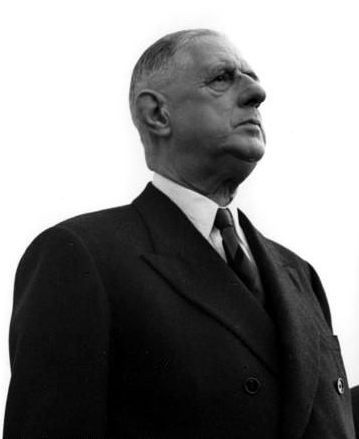
Charles de Gaulle was born in Lille, France, on 22nd November, 1890. The son of a headmaster of a Jesuit school, he was educated in Paris. He was a good student and at the Military Academy St. Cyr, he graduated 13th in the class of 1912.
Commissioned as a second lieutenant, the 6 feet 5 tall de Gaulle joined an infantry regiment commanded by Colonel Henri-Philippe Petain in 1913.
In the First World War de Gaulle was wounded twice in the first few months of the conflict. Promoted to the rank of captain in February, 1915, de Gaulle fought at Verdun where he was wounded again and on 2nd March, 1916 was captured by the German Army. Over the next 32 months he was held in several prisoner of war camps and made five unsuccessful attempts to escape.
After the Armistice de Gaulle was assigned to a Polish division being formed in France where he served under Maxime Weygand. He fought against the Red Army during the Civil War and won Poland's highest military decoration, Virtuti Militari.
De Gaulle lectured at the French War College where he worked closely with Henri-Philippe Petain. Over the next few years the two men demanding a small, mobile, highly mechanized army of professionals.
De Gaulle's military ideas appeared in his book, The Army of the Future (1934). In the book he also criticized the static theories of war that was exemplified by the Maginot Line. The book was unpopular with the politicians and the military who favoured the idea of a mass army of conscripts during war. In 1936 de Gaulle was punished for his views by having his name taken of the promotion list.
In 1938 de Gaulle published France and Her Army. This book caused a disagreement with Henri-Philippe Petain who accused de Gaulle of taking credit for work done by the staff of the French War College.
On the outbreak of the Second World War de Gaulle took over command of the 5th Army's tank force in Alsace. He soon became frustrated with the military hierarchy who had failed to grasp the importance of using tanks in mass-attacks with air support.
When the German Army broke through at Sedan he was given command of the recently formed 4th Armoured Division. With 200 tanks, de Gaulle attacked the German panzers at Montcornet on 17th May, 1940. Lacking air support, de Gaulle made little impact on halting the German advance.
De Gaulle was more successful at Caumont (28th May) when he became the only French commanding officer to force the Germans to retreat during the German Invasion of France.
On the 5th June, 1940, the French prime minister, Paul Reynaud, sacked Edouard Daladier and appointed de Gaulle as his minister of war. De Gaulle also visited London but when he returned to France on 16th June he discovered the Henri-Philippe Petain had ousted Paul Reynaud as premier and was forming a government that would seek an armistice with Germany. In danger of being arrested by the new French government, de Gaulle returned to England. The following day he made a radio broadcast calling for French people to continue fighting against the German Army.
Whereas as President Franklin D. Roosevelt in the USA recognized Vichy France Winston Churchill refused and backed de Gaulle as leader of the "Free French". Henri-Philippe Petain responded by denouncing de Gaulle. On 4th July, 1940, a court-martial in Toulouse sentenced him in absentia to four years in prison. At a second court-martial on 2nd August, 1940, sentenced him to death.
De Gaulle made attempts to unify the resistance movements in France. In March 1943 Jean Moulin, Charles Delestraint and Andre Dewavrin managed to unite eight major resistance movements under de Gaulle's leadership. However, this good work was undermined when in June, 1943, both Delestraint and Moulin were both arrested by the Gestapo.
On 30th May 1943, de Gaulle moved to Algeria. The following month the French Committee of National Liberation (FCNL) was established with de Gaulle and Henri Giraud as co-presidents. De Gaulle had difficulty working with his co-president and by July, 1943, had limited Giraud's power to command of the armed forces.
Franklin D. Roosevelt and Winston Churchill were furious when de Gaulle's announced on 26 May, 1944, that the FCNL will now be known as the Provisional Government of the French Republic. Roosevelt and Churchill refused to recognize de Gaulle's action and decided to exclude him from the planning of Operation Overlord.
Despite objections from Britain and the USA, De Gaulle's Provisional Government was recognized by Czechoslovakia, Poland, Belgium, Luxembourg, Yugoslavia and Norway. On 13th July, 1944, the governments of Britain and the USA also agreed that de Gaulle could help administer the liberated portions of France.
De Gaulle reached France from Algiers on 20th August 1944. De Gaulle and his 2nd Armoured Division was allowed to join the USA Army when it entered Paris on 25th August. At a public speech later that day he announced that the French Forces of the Interior (FFI) would be integrated into the French Army and the militia would be dissolved. He also offered posts in his government to leaders of the resistance. Those who took office included Georges Bidault, Henry Frenay and Charles Tillon.
De Gaulle was upset by not being invited to the Yalta Conference but he was allowed to represent France as one of the four countries to sign the final instrument of surrender with Germany. France was also given one of the four occupation zones in Germany.
On 13th November, 1945, the first Constituent Assembly unanimously elected de Gaulle as head of the French government. He held the post until resigning on 20th January, 1946. He then formed the right-wing group, the Rally of the French People (RFP). After initial success it declined in popularity and de Gaulle left it in 1953 and it was disbanded two years later.
After his retirement from politics de Gaulle wrote the first three volumes of his memoirs. He returned to politics in 1958 when he was elected president during the Algerian crisis. He granted independence to all 13 French African colonies but the Algerian War continued until 1962.
De Gaulle decided that France should have its own atom bomb and repeatedly blocked Britain's attempts to join the European Economic Community. In 1966 de Gaulle withdrew France from the integrated military command of NATO.
Following student riots against his government and negative results in a referendum, de Gaulle resigned from office in April, 1969. In retirement he completed his memoirs. Charles De Gaulle died on 9th November, 1970.
(Source: http://www.spartacus.schoolnet.co.uk/...)
More:
http://en.wikipedia.org/wiki/Charles_...
http://www.bbc.co.uk/history/historic...
 Alec Douglas-Home:
Alec Douglas-Home: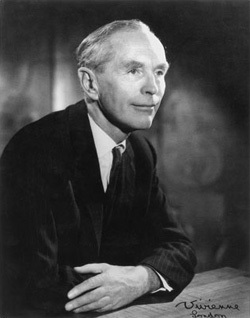
In 1931, he entered Parliament as a Scottish Unionist Party (merged with the Conservative Party in 1965) MP for Lanark. As Parliamentary Private Secretary to Prime Minister Neville Chamberlin from 1937-39, he attended the Munich Conference in 1938, though was not tainted by the fallout. Severe illness during World War Two prevented him from active participation, and he lost his seat in the 1945 General Election. After Home’s father passed away, he became the 14th Earl of Home and took a seat in the House of Lords. He served as Commonwealth Secretary during the Suez Crisis of 1956, in addition to holding the positions of Leader of the House of Lords and Lord President of the Council.
In 1959, the Conservative Party under Harold Macmillan won the General Election. The following year, Home was appointed Foreign Secretary. He remained in the role until 18 October 1963, when Macmillan suddenly resigned due to a prostate condition that was exacerbated by the Profumo Affair.
Home’s ‘emergence’ as the new leader of the Conservative Party attracted some claims that Macmillan had worked to ensure ‘The Magic Circle’ deny Rab Butler the leadership, but Reginald Maudling had also been a strong candidate. Nonetheless, Home renounced his peerage on 23 October 1963 and became Sir Alec Douglas-Home. On 7 November he contested and won the constituency of Kinross and West Perthshire – but for the intervening two weeks he was a Prime Minister who belonged to neither the House of Commons nor the House of Lords.
Home did not originally seek the position of Prime Minister, but was widely respected by his Party and its future leaders. By the time he took over, the Conservative Party had been in office for 12 years and had contested three elections; Home was the fourth party leader during the period. In contrast, Harold Wilson was a formidable leader of the Labour Party. Despite this, Home focused heavily on winning the next election and as a result he narrowed the Labour lead in the opinion polls.
As his biographer DR Thorpe notes, the legacy of Home’s government was the abolition of resale price maintenance, which enabled the cut price stickers on goods we see today. The reform – led by President of the Board of Trade Edward Heath – faced opposition within the party, but Home held firm and the bill was eventually passed. He also took a tough stance in dealing with the trade unions. During Home’s premiership, American President JF Kennedy was assassinated, and relations with Kennedy’s successor Lyndon B Johnson deteriorated after the sale of British Leyland buses to Cuba. Macmillan famously described Home to the Queen as ‘steel painted as wood’.
Home was an unexpected Prime Minister and served for a short 363 days, the second shortest premiership in the 20th century – but he pushed his agenda as he did not see any reason why the Conservative Party would not win a fourth term. The General Election held on 15 October 1964 saw Wilson win a four-seat majority. Despite defeat, Home went on to serve as Foreign Secretary throughout Edward Heath’s premiership from 1970-74.
(Source: http://www.number10.gov.uk/past-prime...)
More:
http://en.wikipedia.org/wiki/Alec_Dou...
http://www.spartacus.schoolnet.co.uk/...
 Anastas Mikoyan:
Anastas Mikoyan:
Anastas Mikoyan was in Sanain, Armenia, on 13th November, 1895. He studied theology but he abandoned the priesthood to join the Bolsheviks in 1915 and took part in the October Revolution in the Caucasus.
During the Civil War he was arrested in Baku by the British Army but escaped and made his way to Moscow where he met Vladimir Lenin and Joseph Stalin and other Bolshevik leaders.
After the death of Vladimir Lenin Mikoyan became a supporter of Joseph Stalin, and was appointed to the Central Committee in 1923 and three years later was appointed people's commissar for external and internal trade. He was willing to learn from advances in the West and introduced the manufacture of canned goods.
In 1935 Mikoyan was elected to the Politburo and during the Second World War served on the State Defence Committee with special responsibility for organizing the transport of supplies. Mikoyan served as minister of trade under Georgy Malenkov. However, he supported Nikita Khrushchev against Malenkov and in February, 1955, was rewarded with the post of deputy premier of the Soviet Union.
After Khrushchev's fall from power, Mikoyan was appointed as chairman of the Presidium of the Supreme Soviet (1964-66). Anastas Mikoyan died in Moscow on 21st October, 1978.
(Source: http://www.spartacus.schoolnet.co.uk/...)
More:
http://en.wikipedia.org/wiki/Anastas_...
Books mentioned in this topic
Agent Orange: History, Science, and the Politics of Uncertainty (other topics)Matterhorn (other topics)
The Naked and the Dead (other topics)
The Thin Red Line (other topics)
A Bright Shining Lie: John Paul Vann and America in Vietnam (other topics)
More...
Authors mentioned in this topic
Edwin A. Martini (other topics)Karl Marlantes (other topics)
Norman Mailer (other topics)
James Jones (other topics)
Neil Sheehan (other topics)
More...






In the fall of 1962, James Meredith risked his life when he successfully applied the laws of integration and became the first black student at the University of Mississippi, a pivotal moment in the civil rights movement.
More:
http://en.wikipedia.org/wiki/James_Me...
http://www.jamesmeredithbooks.com/ind...
http://www.spartacus.schoolnet.co.uk/...
http://microsites.jfklibrary.org/olem...